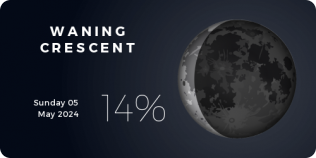[Information]: A Closer Look at The Moon

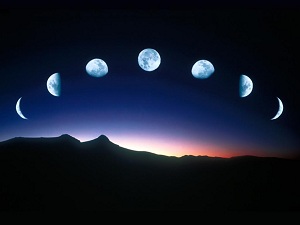
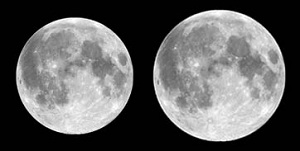
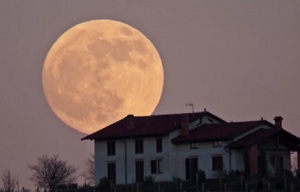
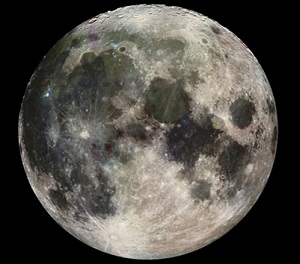

The Moon
The Moon is the only natural satellite of the Earth, and the fifth largest satellite in the Solar System. It is the largest natural satellite of a planet in the Solar System relative to the size of its primary, having a quarter the diameter of Earth and 1/81 its mass.
Orbit: 384,400 km from Earth / Diameter: 3476 km / Mass: 7.35e22 kg
Its prominence in the sky and its regular cycle of phases have made the Moon an important cultural influence on Language, Calendars, Art and Mythology. The Moon's gravitational influence produces the Ocean Tides and the minute lengthening of the day.
The Moon is the brightest object in the sky after the Sun. The Moon is the only celestial body other than Earth on which humans have set foot. Several mechanisms have been proposed for the Moon's formation 4.527 ± 0.010 billion years ago, some 3050 million years after the origin of the Solar System.
Phases of the Moon
A lunar phase or phase of the Moon is the appearance of the illuminated (sunlit) portion of the Moon as seen by an observer, usually on Earth. The lunar phases change cyclically as the Moon orbits the Earth, according to the changing relative positions of the Earth, Moon, and Sun. The half of the lunar surface facing the Sun is always sunlit, but the portion of this illuminated hemisphere that is visible to an observer on Earth can vary from about 100% (Full Moon) to 0% (New Moon). Lunar phases are the result of looking at the illuminated half of the Moon from different viewing geometries; they are not caused by the shadow of the Earth or umbra falling on the Moon's surface (this occurs only during a lunar eclipse). The time between two full Moons (a Lunar Month) is about 29.53 days (29 days, 12 hours, 44 minutes) on average. (Click Lunar Phases for a detailed explanation of the different phases of The Moon).
"Super Moon" - Perigee Moon versus Apogee Moon
Apogee and Perigee refer to the Distance from the Earth to the Moon. Apogee is the farthest point from the Earth. Perigee is the closest point to the Earth and it is in this stage that the Moon appears larger. Looking at the Moon in the sky without anything to compare it to, you wouldn't notice any size difference. But the difference in size can in fact be quite significant (14%). If you were to photograph a Full Moon at Apogee and Perigee (using the same lens), see image on the left to compare the two sizes. The Apogee and Perigee of the Moon have an effect on the tides here on Earth. When the Moon is at Apogee, the furthest distance from the Earth, it has less gravitational pull which, along with other factors that influence the tides, can contribute to lower tides or lower variation in the high/low tide level. When the Moon is at Perigee, this contributes to the opposite effect. (Higher variation in Tides)
.The Moon Cycle
The term "Moon Cycle" refers to the Moon's continuous orbit around the Earth. As the Moon orbits the Earth, its appearance (the "Phase") changes and thus gives us an indication of the Moon's progress in the cycle (the "Age"). The Sun always illuminates exactly one-half of the Moon, but we see it at different angles as it rotates around the Earth. With the naked eye, we can see only the part of the Moon that the Sun is illuminating. For instance, a Crescent Moon is what we call the Moon when we see only a small portion of its illuminated surface. We give the parts of the Moon Cycle different names, according to how the Moon appears to us. In order of appearance: 1) New (also called the Dark Moon) - not visible / 2) Waxing Crescent / 3) First Quarter (commonly called a "Half Moon") / 4) Waxing Gibbous / 5) Full (we can see the entire illuminated portion of the Moon) / 6) Waning Gibbous / 7) Third Quarter (another "Half Moon", but the illuminated part is opposite of the First Quarter) / 8) Waning Crescent / 9) New ( back to the beginning)
NASA and The Moon
U.S. President John F. Kennedy looked for an American project that would capture the public imagination, however a manned Moon landing posed several daunting technical challenges to the U.S. The Saturn V booster became the key to U.S. Moon landings. Vice President Johnson championed the Apollo program. After he became President in 1963, his continuing defense of the program allowed it to succeed in 1969. The Apollo 11 was the first manned mission to land on the Moon on 20 July 1969. A total of twelve men have landed on the Moon. This was accomplished with two US pilot-astronauts flying a Lunar Module on each of six NASA missions across a 41-month time span. The most recent Lunar mission has been the NASA's Lunar Reconnaissance Orbiter mission. The Lunar Precursor Robotic Program (LPRP) is a program of robotic spacecraft missions which NASA will use to prepare for future human spaceflight missions to the Moon. Two missions, the Lunar Reconnaissance Orbiter (LRO) and the Lunar Crater Observation and Sensing Satellite (or LCROSS) were launched on 18 June 2009.

